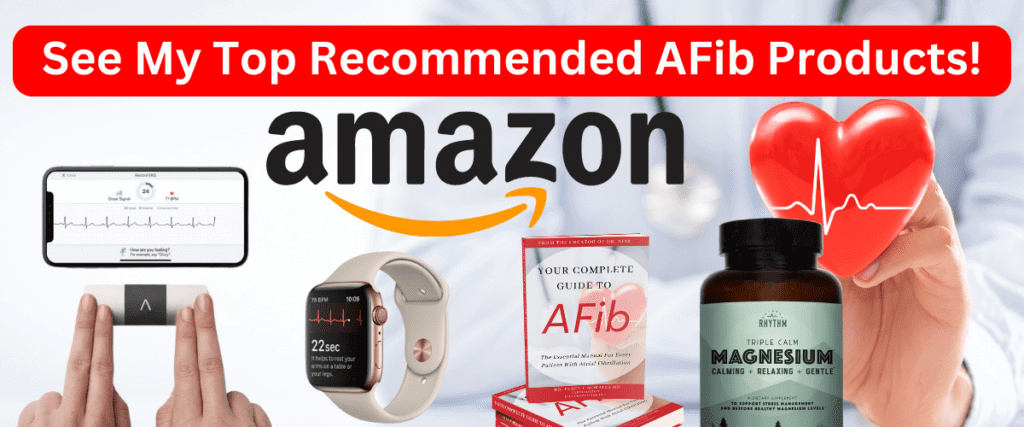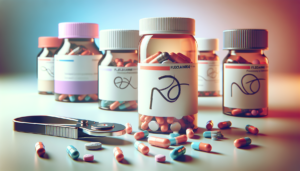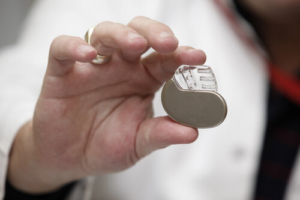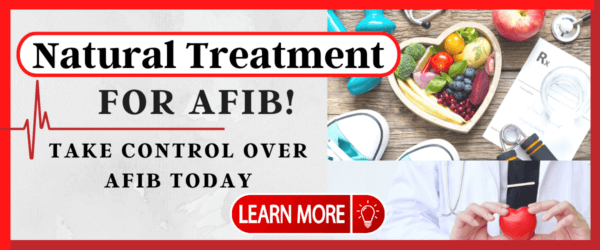Digoxin is a common medication that is used in the treatment of atrial fibrillation — but is it a safe option for every patient?
While digoxin is a viable treatment option for many common heart arrhythmias, it also is a medication with a very narrow therapeutic range (meaning it can very quickly become toxic if taken in elevated dosage).
Digoxin toxicity is a serious concern for every patient using this treatment option to manage their AFib symptoms — which is one of the reasons why educating yourself about the possible benefits, side effects, and signs of digoxin toxicity is essential for any AFib patient on this medication.
If you or someone you love has recently been recommended digoxin for their AFib symptoms, this article is for you. Covering the essential basics of this medication, this is a must-read to improve your knowledge and education about the topic so you can better advocate for your needs when working with your cardiology team.
With all of this in mind, let’s learn everything you need to know about digoxin.
What is Digoxin?
Digoxin is a cardiac medication that is used in the treatment of various heart conditions, including atrial fibrillation, atrial flutters, and congestive heart failure. As a medication that interacts with the electrical properties of the heart, digoxin is used to slow down the heart rate of people living with atrial fibrillation.
First used in the 1930s as an oral or intravenous (IV) medication, digoxin is still one of the most commonly used treatment options for AFib patients.
What is Digoxin Used For?
As a cardiac medication, digoxin is primarily used to treat various heart conditions and diseases. It is a common choice for managing rapid heart rates in the hospital setting as it does not impact a patient’s blood pressure levels. Examples of heart conditions commonly treated with digoxin include:
-
Heart arrhythmias — Conditions that impact the regular rhythm of the heart, including atrial fibrillation, atrial flutters, and supraventricular tachycardia (SVT).
-
Congestive Heart Failure — Conditions that impact the strength and function of a person’s heart, including congestive heart failure and the lasting symptoms from a previous heart attack.
Who Can Take Digoxin?
As a powerful cardiac medication, digoxin is not a safe choice for all patients. Depending on your past medical and family history, you may not be a good candidate for digoxin treatment for AFib. Examples of common comorbidities or conditions that may impede your ability to take digoxin safely include:
-
Having had a previous allergic reaction to digoxin or other cardiac medications
-
Being diagnosed with serious cardiac conditions, including cardiomyopathy, heart block, pericarditis, or myocarditis
-
Having recently had a heart attack
-
A history of kidney disease or injury (digoxin is mostly cleared by the kidneys)
-
Hypothyroidism or hyperthyroidism (conditions that impact your metabolism)
-
Chronic bowel issues, including Crohn’s disease or ulcerative colitis
-
Severe lung diseases like COPD or asthma
-
Rare genetic conditions that affect drug metabolism
-
Unbalanced electrolyte levels
-
Taking medications that interact negatively with digoxin
Before starting digoxin for atrial fibrillation, be sure to talk to your prescribing doctor about your past medical history and the current medications that you take.
How Digoxin Works
Digoxin belongs to the cardiac glycoside class of medication. When taken as directed by your primary care provider, digoxin offers the following benefits:
-
Slowing rapid heart rates — Digoxin affects the electrical activity of the heart by interacting with sodium and potassium channels, helping to slow down the heart rhythm in patients with rapid and irregular arrhythmias, like AFib.
-
Strengthening heart contractions — By interacting with the sodium and potassium sodium channels in the heart, resulting in increased contraction force (or a stronger heartbeat).
-
Decreasing oxygen consumption — By enhancing the function and strength of the heart, less oxygen is needed to pump blood throughout the body. This improvement is noted when at rest and during periods of physiological stress.
Digoxin Side Effects
Like any other medication, taking digoxin can cause you to experience side effects. Some of the most common side effects of digoxin to watch out for and monitor include:
-
Dizziness
-
Increase confusion
-
Loss of appetite
-
Nausea and vomiting
-
Diarrhea
-
Blurred vision
-
Feeling sensitive to bright light
-
Skin rashes
Because digoxin has such a narrow therapeutic range, paying attention to your side effects is crucial for your safety while taking this medication. If you experience the common side effects listed above while taking digoxin, speak to your primary care provider about changing your dose, as you may be experiencing side effects from digoxin.
What is Digoxin Toxicity?
Digoxin toxicity is a serious medical condition that can occur when a person has too much digoxin in their system (either from taking too large of a dose or from poor drug metabolism from the kidneys).
Generally speaking, the higher the dose of digoxin that a patient is on, the higher their risk of experiencing symptoms of digoxin toxicity. These risks can become quite serious quite quickly, as a 2017 study found that for every dosage increase of 0.5 ng/mL of digoxin that a patient took, their risk of death increased by 19%.
Because of the severity of digoxin toxicity, education about potential signs and symptoms is essential for staying safe while taking this medication. Examples of symptoms of digoxin toxicity include:
-
Severe nausea, vomiting, or diarrhea
-
Heart rate beating faster or slower than normal
-
The development of an irregular heart rhythm
-
Visual changes, including blurriness and blind spots
-
An increase or decrease in your need to urinate
-
Generalized body swelling and puffiness
In severe cases of digoxin toxicity, the symptoms can become life-threatening. Examples of severe digoxin toxicity symptoms that require immediate medical intervention include:
-
Shortness of breath and difficulty breathing
-
Profound heart arrhythmias and heart failure
-
Confusion and delirium
-
Loss of consciousness and potential risk of death
Alternative Medications to Digoxin
With all of the potential risk factors that come with taking digoxin, it should come as no surprise that medical providers have looked to replace this common medication with effective and safer options.
Thankfully, due to advances in cardiovascular medicines over the past century since digoxin was discovered, we now have other options that AFib patients regularly take instead. Examples of other rate-controlling medications that can be used to treat AFib instead of digoxin include:
-
Beta-Blockers (such as metoprolol, carvedilol, or atenolol, to name a few)
-
Calcium Channel Blockers (such as Diltiazem or Verapamil)
If your provider is discussing starting you on digoxin for your AFib symptoms, be sure to ask about the potential safety concerns and other medication options that may be able to treat your symptoms with fewer risks over time.
Staying Safe While Taking Digoxin
With all of this being said, it is important to know that it is possible to take digoxin for AFib in a safe way (as long as it is monitored).
As an electrophysiologist with over a decade of experience working with atrial fibrillation patients, I have learned a few helpful pieces of advice that I share with my patients who may need to take digoxin for their symptoms. My top tips for staying safe while taking digoxin for atrial fibrillation include:
-
Only take your medication as prescribed by your doctor — NEVER take an extra dose of digoxin without consulting your primary care physician. If you are a person who struggles to remember to take medications on time or is at risk of doubling up, digoxin is not a good option for you. Only take digoxin as prescribed by your doctor, following their instructions very carefully.
-
Take as low of a dose as possible — Ask your provider to be put on the lowest dose of digoxin possible to offer you benefits. Higher doses of digoxin are connected with increased health risks, so be sure to advocate for yourself to be put on the safest dosing possible.
-
Regularly monitor your blood work — In order to assess the safety and efficacy of your current level of digoxin, you will need to participate in regular blood work to check your digoxin level. If you do not wish to maintain a regular schedule of blood work monitoring, digoxin is not a good medication for you.
-
Pay attention to your symptoms and side effects — If you begin to develop any symptoms or side effects from taking digoxin, report them to your primary care provider immediately. Whenever possible, keeping a symptom diary can be very helpful in diagnosing early-stage digoxin toxicity.
-
Ask your doctor about other options for long-term treatment — Digoxin should ideally not be used as a long-term treatment option for atrial fibrillation. If you are currently taking digoxin, speaking to your doctor to discuss other effective treatment options that could be used for the long-term treatment of your condition can help to reduce your risk of experiencing digoxin toxicity.
The Guide To Reverse Atrial Fibrillation Naturally
If you are interested in natural treatment options for atrial fibrillation and are highly motivated in improving your symptoms naturally, to reduce your need for medications or even procedures, then take a look at my one-of-a-kind, online educational program, Take Control Over AFib.
Lifestyle modifications and reducing inflammation are essential components of the long-term management of atrial fibrillation. Addressing the source cause of atrial fibrillation can lead to a significant benefit for most AFib patients. Targeted lifestyle modifications can reduce your symptoms, reduce your reliance on medications or procedures, and even improve the long-term success rate of procedures for AFib. However, most patients are not given instructions or tips on how to accomplish these essential lifestyle modifications in an AFib targeted style.
This is exactly why I created the Take Control Over AFib Program, to give people a step-by-step plan to improve and potentially reverse atrial fibrillation naturally.
Thinking about lifestyle modifications is easy, but putting in place a system to keep you committed to achieve real results takes time and dedication, and with my step-by-step plan, we can achieve powerful and long-lasting results together.
Putting It All Together
Digoxin is a popular yet controversial medication in the cardiovascular world — offering several benefits when used correctly, but with significant risks for side effects or toxicities.
If you or someone you love has been recommended digoxin for the treatment of atrial fibrillation, it is essential that you educate yourself about the potential risks and dangers of this medication — even if you only take it for a short period of time.
Requiring plenty of monitoring and patient education, digoxin may not be the right medication for your needs — so be sure to speak to your primary care physician to advocate for yourself and determine if there are other safe options for the treatment of your AFib symptoms.
The Best Atrial Fibrillation Book
Your Complete Guide To AFib: The Essential Manual For Every Patient With Atrial Fibrillation
$15.95 (as of April 28, 2024 10:33 GMT -06:00 - More infoProduct prices and availability are accurate as of the date/time indicated and are subject to change. Any price and availability information displayed on [relevant Amazon Site(s), as applicable] at the time of purchase will apply to the purchase of this product.) The A to Z guide on everything you need to know about atrial fibrillation. Written by AFib expert Dr. Percy Morales MD. Over 120 pages of essential information on medications, procedures, and lifestyles modifications for AFib. Easy to read for every patient.
Shop AFib Products on Amazon
KardiaMobile 6-Lead Personal EKG Monitor – Six Views of The Heart – Detects AFib and Irregular Arrhythmias – Instant Results in 30 Seconds – Works with Most Smartphones - FSA/HSA Eligible

KardiaMobile 1-Lead Personal EKG Monitor – Record EKGs at Home – Detects AFib and Irregular Arrhythmias – Instant Results in 30 Seconds – Easy to Use – Works with Most Smartphones - FSA/HSA Eligible

Apple Watch Series 9 [GPS 41mm] Smartwatch with Storm Blue Aluminum Case with Silver Sport Band M/L. Fitness Tracker, Blood Oxygen & ECG Apps, Always-On Retina Display

Fitbit Sense 2 Advanced Health and Fitness Smartwatch with Tools to Manage Stress and Sleep, ECG App, SpO2, 24/7 Heart Rate and GPS, Shadow Grey/Graphite, One Size (S & L Bands Included)

OMRON - Complete Wireless Upper Arm Blood Pressure Monitor + EKG - Built-in Bluetooth Technology
24% Off
Omron Hem 7361T Bluetooth Digital Blood Pressure Monitor with Afib Indicator and 360° Accuracy Intelliwrap Cuff for Most Accurate Measurements (White)
$127.99 (as of April 29, 2024 04:39 GMT -06:00 - More infoProduct prices and availability are accurate as of the date/time indicated and are subject to change. Any price and availability information displayed on [relevant Amazon Site(s), as applicable] at the time of purchase will apply to the purchase of this product.)
EMAY Portable ECG Monitor | Record ECG and Heart Rate Anytime Anywhere | Stand-Alone Device with LCD Screen and Storage | No Subscription Required

SAMSUNG Galaxy Watch 6 44mm Bluetooth Smartwatch, Fitness Tracker, Personalized HR Zones, Advanced Sleep Coaching, Heart Monitor, BIA Sensor, Health Wellness Insights, Big Screen, US Version, Graphite

Natural Rhythm Triple Calm Magnesium 150 mg - 120 Capsules – Magnesium Complex Compound Supplement with Magnesium Glycinate, Malate, and Taurate. Calming Blend for Promoting Rest and Relaxation.

Pure Encapsulations Magnesium (Glycinate) - Supplement to Support Stress Relief, Sleep, Heart Health, Nerves, Muscles, and Metabolism* - with Magnesium Glycinate - 180 Capsules


















![Apple Watch Series 9 [GPS 41mm] Smartwatch with Storm Blue Aluminum Case with Silver Sport Band M/L. Fitness Tracker, Blood Oxygen & ECG Apps, Always-On Retina Display #1](https://m.media-amazon.com/images/I/311xwtp4mFL._SL100_.jpg)
![Apple Watch Series 9 [GPS 41mm] Smartwatch with Storm Blue Aluminum Case with Silver Sport Band M/L. Fitness Tracker, Blood Oxygen & ECG Apps, Always-On Retina Display #2](https://m.media-amazon.com/images/I/41j+8AaUGsL._SL100_.jpg)
![Apple Watch Series 9 [GPS 41mm] Smartwatch with Storm Blue Aluminum Case with Silver Sport Band M/L. Fitness Tracker, Blood Oxygen & ECG Apps, Always-On Retina Display #3](https://m.media-amazon.com/images/I/41jIyxZitnL._SL100_.jpg)
![Apple Watch Series 9 [GPS 41mm] Smartwatch with Storm Blue Aluminum Case with Silver Sport Band M/L. Fitness Tracker, Blood Oxygen & ECG Apps, Always-On Retina Display #4](https://m.media-amazon.com/images/I/41IpNJERjCL._SL100_.jpg)
![Apple Watch Series 9 [GPS 41mm] Smartwatch with Storm Blue Aluminum Case with Silver Sport Band M/L. Fitness Tracker, Blood Oxygen & ECG Apps, Always-On Retina Display #5](https://m.media-amazon.com/images/I/31o17yhfYpL._SL100_.jpg)

















































